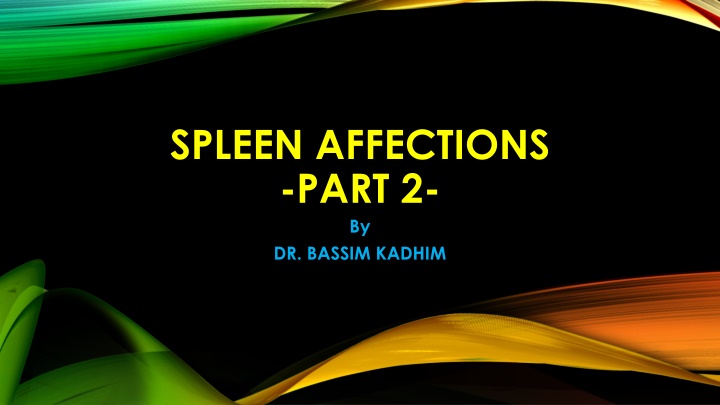
Splenic Affections - Part 2 by Dr. Bassim Kadhim
Explore various splenic conditions such as abscesses, cysts, infarctions, lacerations, and more in this informative presentation by Dr. Bassim Kadhim. Learn about the causes, symptoms, diagnosis, and treatment options for each condition, including splenic torsion in dogs. Discover the clinical signs, diagnostic approaches like X-ray and ultrasonography, and crucial treatment strategies for managing splenic injuries.
Download Presentation

Please find below an Image/Link to download the presentation.
The content on the website is provided AS IS for your information and personal use only. It may not be sold, licensed, or shared on other websites without obtaining consent from the author. If you encounter any issues during the download, it is possible that the publisher has removed the file from their server.
You are allowed to download the files provided on this website for personal or commercial use, subject to the condition that they are used lawfully. All files are the property of their respective owners.
The content on the website is provided AS IS for your information and personal use only. It may not be sold, licensed, or shared on other websites without obtaining consent from the author.
E N D
Presentation Transcript
SPLEEN AFFECTIONS -PART 2- By DR. BASSIM KADHIM
Splenic affections : 1- Splenic abscess: 2- Splenic cysts : 3- Splenic infarction 4- Splenic laceration and trauma
Splenic laceration and trauma : Laceration is un common compared with trauma Causes : 1-Secondary to abdominal penetration. 2-Iatrogenic injury during diagnostic and therapeutic procedures.
If it involving major splenic arteries or veinsit can be fatal. Trt : 1- I/V fluid administration 2- Abdominal compression bandaging. 3- Serial monitoring of packed cell volume 4- blood transfusion may required. 5- Surgery intervention is considered when medical therapy failed.
Splenic torsion : Occur when spleen rotated around its vascular pedicle. It most commonly reported in large or giant breed dogs ( Great Danes ,German shepherds and Irish setters). It often associated with gastric dilation. Increasing physical activity. ( retching, rolling and exercise), in combination with stretching of splenic ligaments may increase splenic motion.
Clinical signs : It may be acute or chronic condition. Acute : Abdominal pain. and pale m.m. Chronic condition : Intermittent abdominal pain, vomiting , anorexia , abdominal distention , weight loss , polyuria , polydipsia and pale m.m. Leukocytosis and thrombocytopenia and anemia . Increase hepatic enzymes and pancreatic enzymes.
Diagnosis : X-ray reveal : C-shape spleen Air opacities within splenic parenchyma Loos of abdominal details.
Ultrasonography : 1- splenic congestion 2- increase of diameter of parenchymal vessels 3- Localized evidence of splenic infarction.
TRT : Patient must adequately stabilized with fluid therapy or blood products. Surgical intervention to remove splenic damage.
Splenic neoplasms : They are a common condition in dogs and reach to 50% compared with cats which reach to 37%. The most common neoplasms in dog are hemangiocarcinoma 80% . Other neoplasms are leiomyosarcoma , fibrosarcoma ,liposarcoma While in cats are lymphosarcoma and mast cell tumor.
Clinical signs : Decrease appetite or anorexia Weight loss Abdominal distention Abdominal pain Pale m.m. Polydipsia Lethargy Muscle weakness
Diagnosis : X-ray reveal : Abdominal mass. Mass may be difficult to identify with abdominal fluid or blood. Pulmonary opacities Increased sternal lymph nodes.
TRT : Complete splenectomy animal will survive to 86 days and only 6% survive one year.
Diagnostic sampling of the spleen : 1- Closed percutaneous fine needle aspiration 2-Tru Cut biopsy. 3- Direct surgical biopsy
Complications of splenectomy : It divided into immediate and late. Immediate : Hemorrhage Vascular obstruction to pancreas Cardiac arrhythmias.
Late complications : Increased bacterial infection Hemoparasitic infection Anemia Sepsis Pancreatic infarction Increase of platelets
